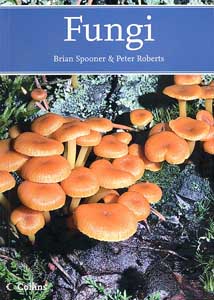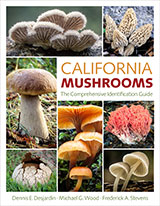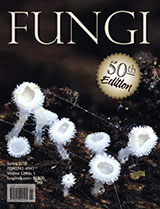Book Review
Fungi
This recent addition to the longrunning Collins New Naturalist Series replaces the popular seventh volume, Mushrooms and Toadstools, written by John Ramsbottom in the early 1950s and in print until the mid 1980s. According to the publisher, "The aim of this series is to interest the general reader in the wildlife (in a broader sense than we use in North America) of Britain by recapturing the enquiring spirit of the old naturalists. The editors believe that the natural pride of the British public in the native flora, fauna, and fungi, to which must be added concern for their conservation, is best fostered by maintaining a high standard of accuracy combined with clarity of exposition in presenting the results of modern scientific research". Other volumes in the series deal with topics such as lichens, bats, moths, and regions of Britain including the Lake District, Northumberland, and the seashore.

As a rule, most people know little or nothing about such things as lichens, moths, bats, and fungi (and don't care about them), so I consider Collins's longstanding commitment to including under-appreciated organisms in this series quite praiseworthy. The authors of this new volume are both mycologists at the Royal Botanic Gardens, Kew, and are well known in mycological circles. In keeping with the editors' intent for the series, they present in accessible fashion a wealth of interesting and up-to-date information about what fungi do and why they are important.
The 18 chapter titles give a good sense of what to expect: Neither plants nor animals; Evolution and diversity; Agents of decay; Mycorrhizae: promoters of growth; Partners and providers; Parasites and predators; Dispersal; Grass and grassland; Trees and woodland; Dunes and heathland; Freshwater; Marine and salt marsh; Specialised natural habitats; Manmade habitats; Fungi and health; Folklore and traditional use; Food and technology; and Conservation.
In addition to presenting much widely known material, Spooner and Roberts have done an excellent job of culling many interesting findings about fungi from the recent, as well as the not-so-recent, research literature. For instance, I was pleased to see the story of how chlorophyll-free plants such as Indian pipe and pine drops derive their nutrition from ectomycorrhizal fungi – they are not saprophytes as many botany books and field guides would have you believe. They also call attention to the frequent association (at least spatially) of fruiting bodies of Amanita muscaria and Boletus (Chalciporus) piperatus. I have observed these two commingling in several different areas in North America and Europe, but this is the first reference I have run across of anyone else noticing the same thing. The authors speculate that there may be a parasitic relationship between the two fungi, in much the same fashion that species of Gomphidius have been shown to be parasitic on Suillus mycorrhizas.
The writing generally is clear and easy to follow, with the exception of an occasional passage that left me scratching my head. Technically, the information is sound, although in the area I know best (mycorrhizas) some points were a bit out-dated. However, given the wide range of fungi and fungal activities covered in the book, it would not be realistic to expect any one or two authors to be upto- the-minute on everything. The text is illustrated primarily with color photographs, most of which are of high quality. There also are a few black and white photographs, line drawings, and reproductions of color paintings.
Overall, this is an excellent look at what fungi are doing out there. Given the amount of information covered, it is probably best approached by taking it in a bit at a time, rather than trying to assimilate all 594 pages straight through. Anyone who spends even a little time among its pages will learn something new – probably many things. An interesting and worthwhile read.
— Review by Steve Trudell, Seattle, WA
— Original review in The Mycophile 47:4, 2006


